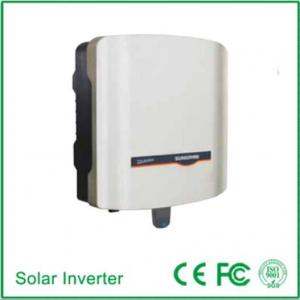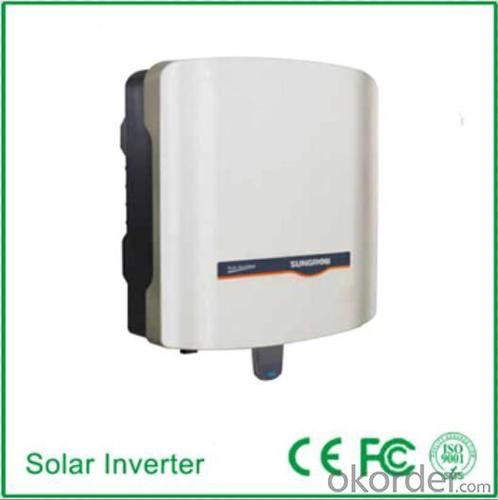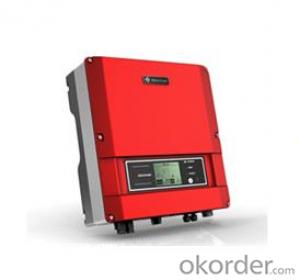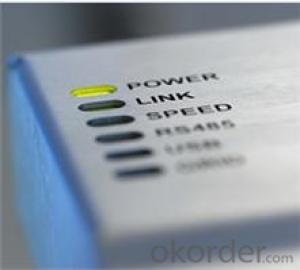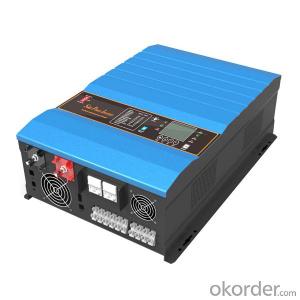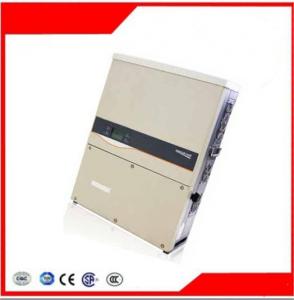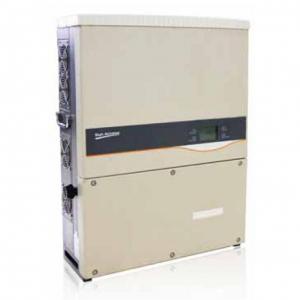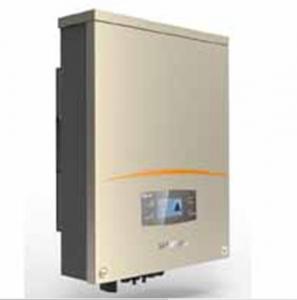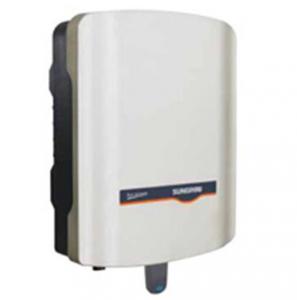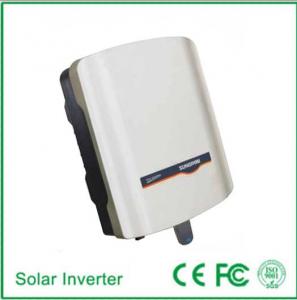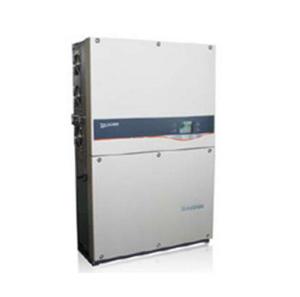Sma Solar Inverter Photovoltaic Grid-Connected Inverter SG4KTL-S
- Loading Port:
- China Main Port
- Payment Terms:
- TT or LC
- Min Order Qty:
- 50000 unit
- Supply Capability:
- 3000000 unit/month
OKorder Service Pledge
OKorder Financial Service
You Might Also Like
1. Structure of Photovoltaic Grid-Connected Inverter SG4KTL-S Description
A solar inverter, or PV inverter, or Solar converter, converts the variable direct current (DC) output of a photovoltaic (PV) solar panel into
autility frequency alternating current (AC) that can be fed into a commercial electrical grid or used by a local, off-grid electrical network.
It is acritical BOS–component in a photovoltaic system, allowing the use of ordinary AC-powered equipment. Solar inverters have
special functions adapted for use with photovoltaic arrays, including maximum power point tracking and anti-islanding protection.
Suitable for 50Hz/60Hz grid, could be used in Asia, Africa and Europe. Available for hand installation, no need for lifting machinery
assistance.
2. Main Features of the Photovoltaic Grid-Connected Inverter SG4KTL-S
• Max. input voltage 600V, compatible with different PV panel and string design
• Only 9kg, easy for handling and installation
• Max. Efficiency at 98.0%
• Ultra-quiet, suitable for residential use
• Access to home WiFi system, easy to enjoy the online monitoring
• Wireless communication design, intelligent mobile phone local and remote monitoring
• Product certification: TÜV, CE, AS4777, AS/NZS 3100, VDE AR N 4105
• Manufacturer certification: ISO 9001, ISO 14001, OHSAS 18000
3. Photovoltaic Grid-Connected Inverter SG4KTL-S Images
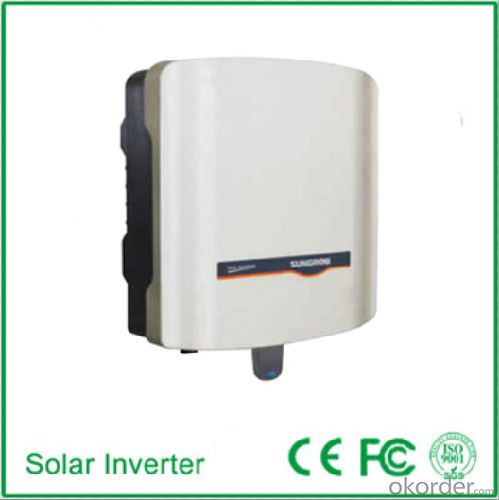
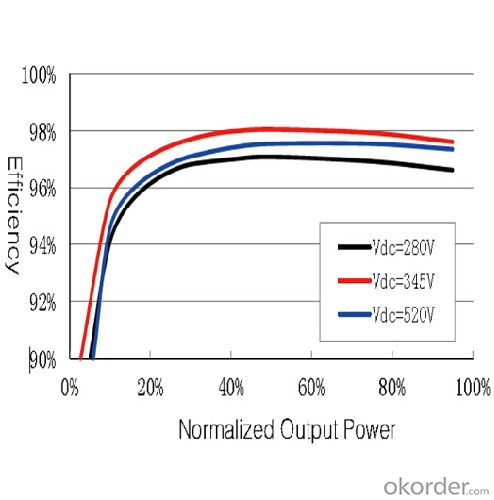
4. Photovoltaic Grid-Connected Inverter SG4KTL-S Specification
Input Side Data | |
| Max. PV input power | 4300W |
| Max. PV input voltage | 600V |
| Startup voltage | 150V |
| Nominal input voltage | 345V |
| MPP voltage range | 125~560V |
| MPP voltage range for nominal power | 240~520V |
| No. of MPPTs | 1 |
| Max. number of PV strings per MPPT | 2 |
| Max. PV input current | 18A |
| Max. current for input connector | 20A |
| Output Side Data | |
| Nominal AC output power | 4000W |
| Max AC output power(PF=1) | 4210W |
| Max. AC output apparent power | 4210VA |
| Max. AC output current | 18.3A |
| Nominal AC voltage | 230Vac (Single phase) |
| AC voltage range | 180~276Vac (May vary as per corresponding country’s grid standard) |
| Nominal grid frequency | 50Hz/60Hz |
| Grid frequency range | 45~55Hz/55~65Hz (May vary as per corresponding country’s grid standard) |
| THD | < 3 % (Nominal power) |
| DC current injection | <0.5 %In |
| Power factor | >0.99@default value at nominal power, (adj. 0.8 overexited~0.8 underexcited) |
| Protection | |
| Anti-islanding protection | YES |
| LVRT | NO |
| DC reverse connection protection | YES |
| AC short circuit protection | YES |
| Leakage current protection | YES |
| DC switch | Optional |
| DC fuse | NO |
| Overvoltage protection | Varistors |
| System Data | |
| Max. efficiency | 98.00% |
| Max. European efficiency | 97.50% |
| Isolation method | Transformerless |
| Ingress protection rating | IP65 |
| Night power consumption | <1W |
| Operating ambient temperature range | -25~60℃ (>45℃ derating) |
| Allowable relative humidity range | 0~100% |
| Cooling method | Natural cooling |
| Max. operating altitude | 4000m (>2000m derating) |
| Display | LED, LCD(optional) |
| Communication | WiFi (optional) |
| DC connection type | MC4 |
| AC connection type | Plug and play connector |
| Certification | IEC61000-6-2,IEC61000-6-3, |
| AS/NZS3100,AS4777.2,AS4777.3 | |
| VDE-AR-N-4105, VDE0126-1-1,CE,G83/2,C10/11,EN50438,CGC | |
| Mechanical Data | |
| Dimensions(W×H×D) | 300*370*125 mm |
| Mounting method | Wall bracket |
| Weight | 9kg |
5. FAQ of Photovoltaic Grid-Connected Inverter SG4KTL-S
Q1:Which payment terms can you accept?
A1:T/T,L/C,Moneygram,Paypal are available for us.
Q2:Can we visit your factory?
A2:Sure,welcome at any time,seeing is believing.
- Q: Can a solar inverter be connected to a battery storage system?
- Yes, a solar inverter can be connected to a battery storage system. This allows excess solar energy generated during the day to be stored in the batteries and used later when there is no sunlight, providing a reliable source of power.
- Q: What are the potential risks of overloading a solar inverter?
- Overloading a solar inverter can lead to several potential risks. Firstly, it can cause the inverter to overheat, which can result in damage to the internal components and reduce its lifespan. Secondly, overloading can cause the inverter to shut down or trip, interrupting the solar power generation and potentially causing a power outage. Additionally, overloading the inverter may also compromise the safety of the electrical system, increasing the risk of electrical fires or other hazards. Therefore, it is important to ensure that the solar inverter is properly sized and not overloaded to avoid these potential risks.
- Q: How the output voltage of the PV inverter and the grid-connected voltage are determined
- Inverter is the DC power (battery, battery) into alternating current (usually 220V, 50Hz sine wave). It consists of inverter bridge, control logic and filter circuit. Widely used in air conditioning, home theater, electric wheel, power tools, sewing machines, DVD, VCD, computer, TV, washing machine, range hood, refrigerator, video recorders, massage, fan, lighting and so on. In foreign countries
- Q: Can a solar inverter be used with different types of grounding systems?
- Yes, a solar inverter can be used with different types of grounding systems. Solar inverters are designed to be flexible and adaptable to various electrical systems and grounding configurations. They can be used with grounded, ungrounded, or impedance grounded systems, allowing for compatibility across different types of grounding systems.
- Q: What is the role of power factor correction in a solar inverter?
- The role of power factor correction in a solar inverter is to improve the efficiency and stability of the system by minimizing the reactive power and optimizing the power factor. This ensures that the inverter operates at its highest efficiency and reduces any voltage drops or disturbances in the grid. Additionally, power factor correction helps to comply with grid regulations and standards, preventing penalties and ensuring smooth integration of solar power into the electrical grid.
- Q: Can a solar inverter be used without solar panels?
- No, a solar inverter cannot be used without solar panels. Solar panels are the primary source of energy for a solar inverter, which converts the direct current (DC) generated by the panels into alternating current (AC) that can be used to power electrical devices. Without solar panels, there is no source of renewable energy for the inverter to convert, rendering it useless.
- Q: Can a solar inverter be used with different types of mounting systems?
- Yes, a solar inverter can be used with different types of mounting systems. The inverter is responsible for converting the direct current (DC) produced by solar panels into alternating current (AC) that can be used to power household appliances. The mounting system is independent of the inverter and is designed to securely hold the solar panels in place. As long as the inverter is compatible with the electrical specifications of the solar panels, it can be used with various types of mounting systems such as rooftop, ground-mounted, or tracking systems.
- Q: What is the role of a solar inverter in a solar panel system?
- The role of a solar inverter in a solar panel system is to convert the direct current (DC) electricity generated by the solar panels into alternating current (AC) electricity that can be used to power household appliances and be fed back into the electrical grid. It also ensures that the electricity produced by the solar panels is of the correct voltage and frequency for safe and efficient use in homes and businesses.
- Q: How does the input voltage range affect the performance of a solar inverter?
- The input voltage range directly affects the performance of a solar inverter. If the input voltage falls below the minimum range, the inverter may not be able to convert the DC power from the solar panels into usable AC power efficiently or at all. On the other hand, if the input voltage exceeds the maximum range, it can potentially damage the inverter. Therefore, it is crucial to ensure that the input voltage remains within the specified range for optimal performance and longevity of the solar inverter.
- Q: Can a solar inverter be used with electric vehicles?
- Yes, a solar inverter can be used with electric vehicles. Solar inverters are used to convert the DC (direct current) electricity generated from solar panels into AC (alternating current) electricity which can be used to power various devices, including electric vehicles. This allows for the charging of electric vehicles with clean and renewable solar energy.
Send your message to us
Sma Solar Inverter Photovoltaic Grid-Connected Inverter SG4KTL-S
- Loading Port:
- China Main Port
- Payment Terms:
- TT or LC
- Min Order Qty:
- 50000 unit
- Supply Capability:
- 3000000 unit/month
OKorder Service Pledge
OKorder Financial Service
Similar products
Hot products
Hot Searches
Related keywords
